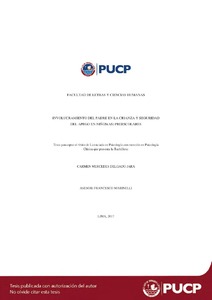| dc.contributor.advisor | Marinelli, Francesco | es_ES |
| dc.contributor.author | Delgado Jara, Carmen Mercedes | es_ES |
| dc.date.accessioned | 2018-01-24T17:49:31Z | es_ES |
| dc.date.available | 2018-01-24T17:49:31Z | es_ES |
| dc.date.created | 2017 | es_ES |
| dc.date.issued | 2018-01-24 | es_ES |
| dc.identifier.uri | http://hdl.handle.net/20.500.12404/9940 | |
| dc.description.abstract | La presente investigación tiene como objetivo evaluar la relación entre el involucramiento
paterno y la conducta de base segura del niño. Para este propósito se evaluó a 20 padres entre
26 y 45 años (M = 35, DE = 5.38) con sus hijos de edades entre los 40 y 65 meses (M = 53.9,
DE = 8.75) de nivel socioeconómico medio. Se usó la Escala de Compromiso Paterno (Escala
CP; Domecq, 2010) para medir el involucramiento paterno y el Attachment Q-Set 3.0 (AQS;
Waters, 1995) para evaluar la conducta de base segura de los niños. Se halló una relación
significativa y directa entre ambos constructos, así como entre el involucramiento paterno
global y la dimensión Búsqueda de proximidad con el padre de la conducta de base segura
del niño. Además, se encontró una relación significativa y directa entre las áreas del
involucramiento paterno Apertura al mundo y Soporte emocional, y la seguridad global del
niño. Como objetivo específico, se buscó describir el involucramiento paterno, encontrando
niveles medios a bajos, y que este no varía en función de la edad del padre ni el sexo del niño.
Respecto al segundo objetivo específico, al comparar los puntajes observados de seguridad
del niño(a) con los criterios ideales, se encuentra que la dimensión Calidez en las
interacciones con el cuidador observada en la interacción entre padres e hijos participantes
no presenta diferencias significativas con el ideal teórico. Estos resultados señalan la
importancia de la evaluación del involucramiento paterno como una variable a considerar en
el estudio del desarrollo de la seguridad en el vínculo padre–niño. | es_ES |
| dc.description.abstract | This research aims to establish the relation between father involvement and father-child
attachment security. For this purpose, we evaluated 20 parents aged between 26 and 45 years
(M = 35, DE = 5.38), as well as their children aged between 40 y 65 months (M = 53.9, DE =
8.75) from a middle socioeconomic status. The instruments used were Escala de Compromiso
Paterno (Escala CP; Domecq, 2010), for father involvement, and the Attachment Q-Set 3.0
(AQS; Waters, 1995), for father-child attachment security. The results show a strong
statistically significant relation between these two constructs, and also between global father
involvement and the father-child attachment security dimension Proximity to father. Besides,
we found a strong and statistically significant relation between the father involvement areas
Opening to world and Emotional support, and global father-child attachment security.
Additionally, the study had the specific objective of describing father involvement, finding
middle to low scores, and that it does not have relation neither with the age of the fathers nor
with the sex of the children. In respect of a second specific objective, we described the secure
base behavior, from a comparison in observations points and the ideal criteria proposed by
experts. Only in the observed dimension Smooth interaction there was no difference with
theoretical ideal. These results show the importance of the father involvement assessment as a
variable to consider when studying the father-child attachment security. | es_ES |
| dc.language.iso | spa | es_ES |
| dc.publisher | Pontificia Universidad Católica del Perú | es_ES |
| dc.rights | Atribución-NoComercial-SinDerivadas 2.5 Perú | * |
| dc.rights | info:eu-repo/semantics/openAccess | es_ES |
| dc.rights.uri | http://creativecommons.org/licenses/by-nc-nd/2.5/pe/ | * |
| dc.subject | Psicología infantil | es_ES |
| dc.subject | Apego | es_ES |
| dc.subject | Crianza de los hijos | es_ES |
| dc.subject | Seguridad infantil (Psicología) | es_ES |
| dc.title | Involucramiento del padre en la crianza y seguridad del apego en niños(as) preescolares | es_ES |
| dc.type | info:eu-repo/semantics/bachelorThesis | es_ES |
| thesis.degree.name | Licenciado en Psicología Clínica | es_ES |
| thesis.degree.level | Título Profesional | es_ES |
| thesis.degree.grantor | Pontificia Universidad Católica del Perú. Facultad de Letras y Ciencias Humanas | es_ES |
| thesis.degree.discipline | Psicología Clínica | es_ES |
| renati.discipline | 313026 | es_ES |
| renati.level | https://purl.org/pe-repo/renati/level#tituloProfesional | es_ES |
| renati.type | http://purl.org/pe-repo/renati/type#tesis | es_ES |
| dc.publisher.country | PE | es_ES |
| dc.subject.ocde | https://purl.org/pe-repo/ocde/ford#5.01.00 | es_ES |






